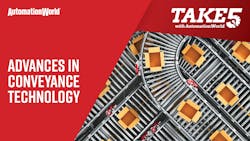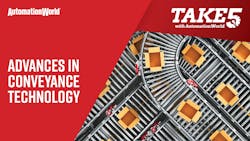
Quick hits:
- IIoT and Industry 4.0 are changing conveyance technology
- Motor-driven roller conveyors that divide a line into separate zones can assist in moving products of different shapes and sizes along a common track
- Other flexible solutions such as Beckhoff’s X-Planar can allow manufacturers to transport products as batches of one
Related to this episode:
- Why conveyance technologies remain an industry lynchpin
- Plasmatreat redesigns equipment to incorporate XPlanar floating movers from Beckhoff
- Technology Matters video discussing Beckhoff's XPlanar technology debut at PACK EXPO Connects
- Gain an in-depth look at PMMI's research on automation and hear from experts on industry topics by visiting PMMI's Business Intelligence video library.
Hello and welcome to Take Five with Automation World. I'm David Miller, senior technical writer for Automation World.
This week, I'd like to discuss conveyance. And this is the fundamental means by which plant operators get materials from point A to point B in their facilities. I want to look at how it's evolved in recent years. Conveyance systems have been around for a very long time, so long in fact, that I really don't think we'd be amiss to consider them one of the first technologies that really actually sought to mechanically automate what formerly would have been performed by manual labor. And there are all kinds of conveyors, of course, as I'm sure our listeners know. There's typical belt conveyors of various types, spiral conveyors, and even hanging conveyors. But the thing is, we often don't talk about them precisely because they're so quintessential. It's a bit like that old joke where the fish swims by two others and says, "How's the water?" And then of course the two younger fish, they turn to each other and they say, "What's water?" They don't even know what it is because they're so completely surrounded by it.
But in connection with other changes that are happening due to the explosion of IIOT and Industry 4.0 technologies, there is a lot of innovation happening in the convenience space too. And we should pay attention to it. One easy example of this, of course, is the implementation of motor driven roller conveyors. These are conveyors that are broken into many different zones. Each of which is powered by a single small motor that's outfitted with digital feedback sensors and a variable frequency drive. What this means essentially is that you can achieve what's called zero pressure accumulation. So if you're moving many different packages that might be different shapes or different sizes, the products don't ever need to physically touch.
In fact, because the conveyor is broken into zones, you could even stop the movement of one good while the others that are ahead of it in the line actually continued moving. So the result of this is that it not only reduces the kind of back pressure and friction that may cause wear and tear on conveyance systems when products build up on a line, but it can also allow different products that are being worked on by other peripheral devices, such as robotic arms can move down the line more efficiently. So if one needs to stop for longer, the others that are ahead of it, keep moving. That's a simple way to put it. And again, it's those feedback sensors, their ability to communicate their information to a VFD and other devices such as robotic arms that make this possible. So it really is a part of digital transformation in that way.
Another interesting technology that's even newer is the XPlanar system from Beckhoff. And this is even more unique than the motor driven roller conveyance concepts that we actually see common across many different companies. Whereas with the motor driven rollers, you have zones on them that can break up goods into smaller batches, the XPlanar actually gives you a true batch of one. It works using planar movers, these flat square tiles that actually levitate above a magnetic tiled surface. And there's a few different benefits you get with this. For one, you are entirely unimpeded by the limitations of a sub track. So these planar movers can rearrange themselves, reorient themselves. They can move diagonally, horizontally, whatever it is you need. So this is a very flexible system.
In addition, these tiles can actually rotate and spin in place. So what we've seen this used for is actually mixing fluids in chemical and pharmaceutical applications. For instance, there will be a small vial and fluids will be added to it, and then the panel will spin and the centrifugal force of the spinning will actually mix the fluids. It seems simple, but previously that would have been much more difficult to accomplish in an automated manner.
So these are just two examples of the many, many other advanced forms of conveyance that are out on the market right now. We see a few trends here that recur elsewhere, in addition. We see modularity, flexibility and so forth. So it's really consonant with other things we see happening in industry, and there's a lot of innovation happening in this space. So it really goes against the old adage that there's nothing new under the sun.
In any case, that's everything I have for you today. But if you enjoyed this segment, do continue tuning in for more to come in the weeks ahead.
